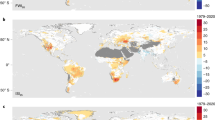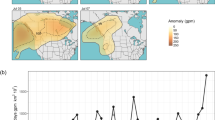Summary
There is evidence that the area burned by wildland fire has increased in certain regions of Canada in recent decades. One cause for this increase is changes in the mid-tropospheric circulation at 500 hPa over northern North America. This study examines the physical links between anomalous mid-tropospheric circulation over various regions of Canada and wildland fire severity. Analysis of monthly and seasonal burned areas for the period 1953 to 1995 reveals a bimodal distribution with distinct low and extreme high burned area years. The high/low burned area years coincide with positive/negative 500 hPa height anomalies over north-western, western, west-central and east-central Canada. Total area burned and the 500 hPa height anomaly data are analyzed for statistical relationships using the Spearman rank correlation non-parametric measure. Results for the May to August fire season indicate statistically significant correlations between regional total area burned and clusters of anomalous 500 hPa geopotential height values immediately over, and immediately upstream of the affected region. For the north-western and west-central regions, significantly correlated clusters are found in the central Pacific as well, providing evidence of the influence of a teleconnection structure on the summer climate of western and north-western North America. Two sample comparison tests show statistically significant differences in both the means and variances of the fire data populations during negative and positive phases of mid-tropospheric flow, and the means of the height anomaly populations during extremely high and extremely low area burned seasons. Increases in regional total area burned are related to increases in mean 500 hPa heights, taken from the significantly correlated clusters of height values, between two successive periods 1953–74 and 1975–95. For Canada as a whole, the five lowest area burned seasons all occurred during the early period, while the five highest seasons occurred during the later period. The difference in the geopotential height fields between the two periods identifies an increase in 500 hPa heights over most of Canada with an amplification of the western Canada ridge and an eastward shifted Canadian Polar Trough (CPT).
Similar content being viewed by others
Author information
Authors and Affiliations
Additional information
Received October 19, 1998
Rights and permissions
About this article
Cite this article
Skinner, W., Stocks, B., Martell, D. et al. The Association Between Circulation Anomaliesin the Mid-Troposphere and Area Burnedby Wildland Fire in Canada. Theor Appl Climatol 63, 89–105 (1999). https://doi.org/10.1007/s007040050095
Issue Date:
DOI: https://doi.org/10.1007/s007040050095




